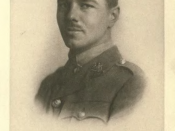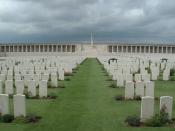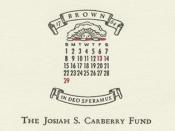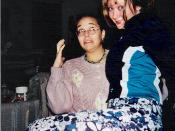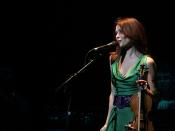In her poem "Leningrad Cemetery, Winter of 1941", Sharon Olds very frankly and very succinctly states her opinions on war, fighting, and the so-called "lust of the eye". She goes about this in such a manner that it is at once pleasing and eye opening to the reader. Wilfred Owens "Dulce et Decorum Est" deals with this same topic, with much the same feeling, but goes about it in more gruesome and personal way. Through both of these poems, the reader is shown that there is no beauty in war, when examined closely. To make their points, both authors use harsh diction, vivid imagery, a mournful tone, and gripping line breaks.
The words used by Olds tell us as much about her views as does the poem in its entirety. Throughout this piece Olds uses very harsh and cold words to give the reader chills and, hopefully, a feeling of the frostbitten tundra of Russia that these warriors were fighting in.
From the very beginning you are given the feeling of this bitter cold, so cold that "the ground was frozen" (2). In addition, she says that the "gravediggers [were] weak from hunger" (2), giving the feeling that all is dead in this frozen wasteland, not only the soldiers, but those who are to bury them. Even nature itself has been seemingly destroyed by its own harsh surroundings. This is most certainly not the same glorious portrayal of war that is seen through the "lust of eye", but in fact, there are very few eyes left alive to lust over anything at all.
Owen uses a sharp and biting choice of words as well. Using pointed and sharp sounding words, such as 'knock-kneed, coughing" (2) gives the reader a definite feeling of the harshness of war, almost like the crackling of machine gun bursts. In addition to this sharp sound, Owen makes use of many action words near the end, like "guttering, chocking, drowning"(16) to give a frantic feeling to this mans last moments of life, the reader can feel the mans pointless struggle for life. This is very powerful; in that it gives the reader excited anticipation, and makes them want to continue. These are all very similar to the methods used by Olds to convey her message. One tool used by Owen more than Olds, though, is that of the particularly gruesome details. Owen uses the phrases "gargling from the froth-corrupted lungs"(22), "obscene as cancer, bitter as cud"(23), and "vile incurable sores on innocent tongues" to again portray war as the sickening entity that it is. Like Olds, he uses very detailed and personal images to combat Gray's idea of the sublime.
While the reader is not given a glorious and heroic picture to lust over, it is, nonetheless, given a clear and vivid picture to gaze upon. Olds' poem uses very vivid imagery to give the reader a grim view of this bleak and sorrowful scene. Images of corpses "wrapped in dark cloth" (6) as they await the afterlife fly through ones mind as the mountains of dead that "could not be buried" (1) make themselves as clear as reality. These brave men, many of whom fought seeking the picture given of the lust of the eye, now have not even the dignity of being buried, but instead are left in some sort of limbo, without the finality of a funeral. Wanting life, wanting even life with the "bread made of glue and sawdust", wanting to return to the war that killed them. This grim picture gives the reader a very clear view of Olds' feelings on the atrocities of war.
The imagery of "Dulce et Decorum Est" is also extremely vivid and graphic. Very early on the reader is painted a picture not wholly unlike that of "Leningrad Cemetery", dead strewn about without regard. The soldiers portrayed as weak "old beggars"(1) "coughing like hags"(2). This vision, however, soon strays from the path of "Leningrad Cemetery" and grows very active, frantic, and more disturbing. As the yelling of the man caught by gas comes tearing trough the "hoots"(7) of mortars the visual picture becomes far grimmer. Everything is seen through a "thick green light as under a green sea"(13,14); helping to portray the feeling of drowning as toxic gas fills the once clean air. This grave portrait of death is a perfect antithesis to the "lust of the eye".
These atrocities are also very clearly shown through the tone used in the poem. While reading "Leningrad Cemetery", one cannot help but feel the sorrow and angst felt by the dying becoming the dead, and the living becoming the dying. It all feels very surreal, and often Olds uses different items to evoke these feelings. The "child's sled" (4) for example really brings a sense of reality and loss of innocence to the poem, helping to bring out that surreal tone, the realization that soldiers are people, and that they aren't the only casualties of war. Women, children, and civilians lay in wait of their next life right next to those who had, in one way or another, chosen their fates. Another item that adds to that same overall tone of surrealism is the "ball of roots" (7). A ball of roots "wants to be planted" (8), that's the way it should be. These dead men want, and need, to be planted as well; it's not right that the dead remain lying about. This too adds to the tone, showing that war is wrong; it makes the rest of life go wrong. The final part of this surrealistic tone is that of winter itself. While winter can be seen as death, it also commonly represents purity and cleanliness. The vast beauty of pure white snow disrupted with deep red blood, and the corpses it once belonged to, is not right. War is a disruption of life. And while life may be at times mundane and repetitious, that should not add beauty or grandeur of spectacle to war. It's not only a disruption to monotony, but also a disruption of life itself.
Owens tone is not as mournful and passive as that of Olds. Owen lends a feeling of action to his poem, again with the use of the aforementioned action words, but in the end has a feeling or regret. As he "watch[es] his white eyes writhing in his face"(19), the speakers gives off a tone of helplessness, because he knows there is nothing he can do for his suffering friend. That is the tone given off throughout the entire poem, that feeling of helplessness, which is different from Olds' poem because the speaker is there, experiencing it. Olds views the scene from afar, possibly from a picture. This shows how these two can give the same, or similar, overall message, while experiencing it themselves, and in their poems, in very different ways.
The best way to display this feeling of disruption is the sudden disruption of the poem itself through line breaks. "Leningrad Cemetery" makes much use of nonstandard line stops to bring attention to how wrong war is. Over and over lines are broken off prematurely, not only to bring attention to the line itself, but also to avoid an overall feeling comfort and smoothness while reading the poem. For example, when reading "so they were covered with something" (3) "and taken on a child's sled" (4), attention is brought to the word something. This is important simply to show the lack for adequate facilities, when frozen corpses are wrapped up with whatever scraps of material can be found before they are carted of to be stacked away like so much fire wood. Through this technique, the reader is forced to pay more attention to what is actually being read because it doesn't simple flow off of your tongue like a child's fairytale, it is instead jerky and difficult, like war itself. It disrupts you, and forces you to think and work. This is completely opposite of the idea of the sublime in war, which quite simply takes you in and requires nothing of you.
Owen too makes great use of enjambed lines to add to the reader's experience. At many times during the reading of this poem, the reader feels the need to pause in an abnormal place; this is due to the enjambed lines. When reading "but someone still was yelling out and stumbling" (11) "and floundering like a man in fire or lime" (12) strong emphasis is put on his stumbling and floundering because of it's line break. It adds to the feeling of panic as the soldiers franticly try to put on their gas masks. This is similar to the technique used by Olds to give emphasis, and possibly an emotional connection with the reader, to items of importance in her poem.
These poems, in every way contradict the idea of the sublime, and the lust of the eye. I believe not so much because they believe it doesn't exist, but more because they see it as wrong. Grays ideas of the "lust of the eye" and the sublime are based on a physically detached and emotionally disconnected view of war's intricate ballet of color and motion. The best way to combat that view is by showing the human side of war, as these two authors do so well. Owen has a first hand perspective, and has likely experienced the "lust of the eye" during his years in the armed forces. So he is subsequently trying to help others avoid its grasp. Olds has never experienced that which she condemns because she was an avid anti-war activist. They are both obviously in severe opposition to war, and these works are direct displays of those feelings.
